
The Cove Point Light is a lighthouse located on the west side of Chesapeake Bay in Calvert County, Maryland.

John Callahan House, known previously as Pinkney-Callahan House when it was located on St. John Street, is a historic home in Annapolis, Maryland, United States. The brick home was constructed by John Callahan, a prominent and wealthy Annapolitan who served as the Register of the Western Shore Land Office between 1778 and 1803, around 1785–90. It has been moved twice in efforts to prevent its demolition. In 1900–01, the house was relocated to St. John's Street and then to its present site on Conduit Street in 1972. The home features an unusual gable-end principal façade and a largely intact Georgian/Federal interior finishes. It once served as St. John's College Infirmary.

Cedar Hill is a historic home located on 75 acres (300,000 m2) at Barstow, Calvert County, Maryland, United States. It is one of the few remaining cruciform dwelling houses existing in Maryland, built in the 18th century that is typical of 17th-century architecture. It is a 1+1⁄2-story house with a 2-story porch tower, built of brick laid in Flemish bond. It is now operated as a bed and breakfast, meeting hall, and retreat center.

Grahame House, Graham House, Mansion House, Graeme House, or Patuxent Manor, is a historic home located at Lower Marlboro, Calvert County, Maryland. It is an 18th-century original 1+1⁄2-story brick shell laid in Flemish bond with a steeply pitched gable roof. Later alterations have included the purchase and removal of the fine paneling throughout the house to the Henry Francis du Pont Winterthur Museum. Charles Grahame, for whom the home is named, was associated with Frederick Calvert, sixth Lord Baltimore, through Grahame's brother, David Grahame and with Thomas Johnson, first elected Governor of the State of Maryland, through Grahame's son.
La Veille, or La Veille Place, is a historic home located at Mutual, Calvert County, Maryland, United States. It is a 1+1⁄2-story gambrel-roofed brick house, of Flemish bond construction. A number of early-19th-century outbuildings include: a log corn crib, three barns, several small sheds, and a frame house that was created by the joining of two 18th-century log slave quarters. Between the "Quarters" and the main house is the La Veille family cemetery, enclosed within an elaborate late-19th-century wrought iron fence.
Willow Glenn is a historic home located at Barstow, Calvert County, Maryland, United States. It is an impressive, Georgian structure of grand proportions; constructed entirely of brick in Flemish bond with random glazed headers. The home typifies the kind of dwelling erected by Maryland's wealthiest tobacco planters of the colonial period.
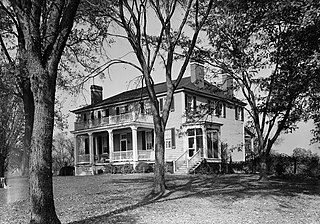
Taney Place is a historic home located at Adelina, Calvert County, Maryland, United States. It is a simple, two-story, hip-roofed, Georgian-style country house, dating from about 1750. It was the birthplace and childhood home of Roger Brooke Taney (1777–1864), who served as Chief Justice of the Supreme Court of the United States from 1836 to 1864.
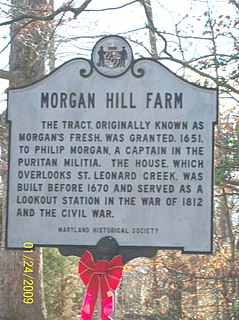
Morgan Hill Farm, also known as Morgan's Fresh or Hill Farm, is a historic home located at Lusby, Calvert County, Maryland. It is a 1+1⁄2-story gable-roofed frame house of a T-shaped plan, with single exterior chimneys on each of the three exposed ends. The original building appears to have been built about 1700, with extensively remodeled in the early 19th century. In 1952 a large rear wing was added to the house. Outbuildings include a one-story log servants' quarter, a log smokehouse, and a large tobacco barn.
Green's Inheritance is a historic home located at Pomfret, Charles County, Maryland, United States. It is a 2+1⁄2-story gable-roofed house of common bond brick, built about 1850. The house has a basic Georgian plan. It is the only brick house in Charles County dating between the years 1835 and 1880. The house was built by Francis Caleb Green, on part of the 2,400 acres (970 ha) of land granted in 1666 to the sons of Thomas Greene, the second Provincial Governor of Maryland, who named it "Green's Inheritance."

The Inns on the National Road is a national historic district near Cumberland, Allegany County, Maryland. It originally consisted of 11 Maryland inns on the National Road and located in Allegany and Garrett counties. Those that remain stand as the physical remains of the almost-legendary hospitality offered on this well-traveled route to the west.
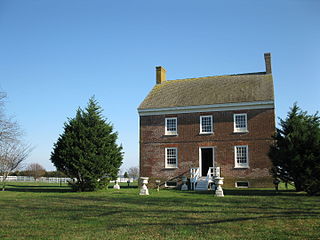
Henry's Grove is a historic home located at Berlin, Worcester County, Maryland, United States. It was built in 1792, and is a 2+1⁄2-story gable-roofed brick house with all walls laid in Flemish bond. The house retains virtually all of its original interior detailing. Also on the property are a 20th-century frame tenant house and four frame outbuildings. It was built for a planter, John Fassitt, whose initials and the date 1792 are inscribed on a plaque in a gable end.

Rehoboth, also known as Turpin Place or Lee Mansion, is a historic home located at Eldorado, Dorchester County, Maryland, United States. It is a 2+1⁄2-story Flemish bond brick house. A chimney rises flush with the one gable end, and a 1+1⁄2-story frame kitchen wing is attached to the other end. The interior of the house was gutted by fire in October 1916, and rebuilt. It was the family home of the second elected Governor of Maryland, Thomas Sim Lee.
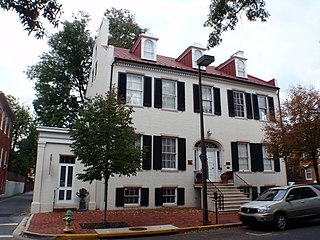
Loats Female Orphan Asylum of Frederick City is a historic home and former orphanage building located at Frederick, Frederick County, Maryland.

John Churchman House is a historic home located at Calvert, Cecil County, Maryland, United States. It consists of two distinct sections: a two-story, three-bay, gable-roofed brick house laid in Flemish bond dated to 1745; and a two-story, two-bay, gable-roofed house built in 1785 of uncoursed fieldstone. It was home to several generations of the locally prominent Churchman family, a number of whose members were important in the religious and educational history of Maryland-Pennsylvania Quakers in the 18th century.

East Nottingham Meetinghouse, or Brick Meetinghouse, is a historic Friends meeting house located at Rising Sun, Cecil County, Maryland. It consists of three different sections: the Flemish bond brick section is the oldest, having been built in 1724, 30 feet 3 inches (9.22 m) by 40 feet 2 inches (12.24 m); the stone addition containing two one-story meeting rooms on the ground floor, each with a corner fireplace at the south corners of the building, and a large youth gallery on the second floor; and in the mid 19th century, a one-story gable roofed structure was added at the southwest corner of the stone section to serve as a women's cloakroom and privy. It is of significance because of its association with William Penn who granted the site "for a Meeting House and Burial Yard, Forever" near the center of the 18,000-acre (73 km2) Nottingham Lots settlement and was at one time the largest Friends meeting house south of Philadelphia. The Philadelphia Half-Yearly Meeting was held here as early as 1725. During the Revolutionary War, an American Army hospital was established here in 1778 for sick and wounded troops under General William Smallwood's command and the Marquis de Lafayette's troops camped in the Meeting House woods on the first night of their march from the Head of Elk to victory at the Battle of Yorktown in 1781.

The Hays-Heighe House is a historic home located on the campus of Harford Community College near Bel Air, Harford County, Maryland, United States. It is a five bay long, two bay deep stone house with a gable roof and massive brick chimneys on each gable, built in 1808. On the east is a five bay long, two-story stone wing. Its initial owner, Thomas A. Hays, was one of the founders of the town of Bel Air.
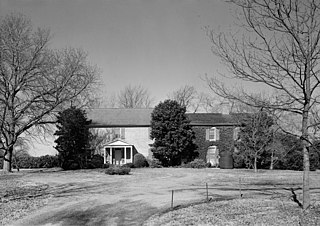
Bowlingly, also known as Neale's Residence and The Ferry House, is a historic home located at Queenstown, Queen Anne's County, Maryland, United States. It is a large brick dwelling house constructed in 1733 on a bluff overlooking Queenstown Creek. The original house is a two-story brick structure that is seven bays long and one room deep, with flush brick chimneys at either end of the pitched gable roof. On August 13, 1813, a flotilla of British Royal Navy warships landed at Bowlingly's wharf during the War of 1812. British troops who disembarked from the warships proceeded to sack the home before being engaging the local Maryland militia.

Lansdowne, also known as Upper Deale or Lansdowne Farm, is a historic home and farm complex located at Centreville, Queen Anne's County, Maryland, United States. It consists of a brick dwelling, and a large barn, granary, and several outbuildings. The house was built in two distinct periods. The earliest house dates to the late colonial period and is a two-story, brick house, three bays wide and two rooms deep, with a single flush chimney on each gable. It is attached to a larger, Federal-period house built in 1823. The later house is brick, two and a half stories high, and was built directly adjoining the west gable of the earlier structure.

Stratton, also known as Hortense Fleckenstein Farm and Solomon Scott Farm, is a historic home located at Centreville, Queen Anne's County, Maryland, United States. It is a center-passage plan house, constructed of brick laid in Flemish bond, four bays wide and one room deep, with flush brick chimneys centered on each end of a pitched gable roof. The house was built about 1790.

Klots Throwing Company Mill is a historic silk mill located at Cumberland in Allegany County, Maryland, United States. It was built in 1902–1903, and is a long two-story brick building with double-gable roofs and paired stepped parapets. An addition was built in 1909. It was operated by Gentex Corporation and closed in 1972. The building was subsequently used for storage. From 1988 until 2002, the north end of the building housed the Western Maryland Food Bank. The building will be converted to loft apartments.





















